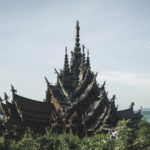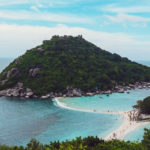Table of Contents
Ayutthaya
The former capital of Thailand, which in the glory days of the city was called the Kingdom of Siam. At the turn of the 17th and 18th centuries, its population reached 1 million inhabitants as much as total in Paris and London at the same time. It was destroyed by the Burmese army in 1768 and abandoned. Then the capital was moved to Bangkok, which began to develop from this memorial, and Ayutthaya overgrew the forest. Currently, it is a town with 66 thousand inhabitants.
Is it worth seeing Ayutthaya?
Ayutthaya is above all the ruins of temples from the time of its magnificence. If during your trip in this region you did not have the opportunity to go to Cambodia and see the ruins of the temple in Siem Reap, it certainly is. If you have already seen them, it is also worth seeing and these Thai ruins.
How to get to Ayutthaya from Bangkok
Ayutthaya is located north of Bangkok and can be reached by train leaving the Hua Lamphong station, which is located next to the MRT final metro station of the same name (Transport in Bangkok). A ticket in the third class, without a seat guarantee, costs 20THB and the journey lasts about 2 hours. (of which 1h through Bangkok)
Transportation in Ayutthaya – bicycle
There is a bicycle rental opposite the train station. The bike costs 50THB for the whole day. In the pledge, we can leave a photocopy of the passport. Unfortunately, there are no bicycle paths everywhere. You have to be ready to cross the river, a 4-band bridge, right next to the cars.
Temples (map)
Some of the temples belong to the Ayutthaya Historical Park and are paid, and some are not. A single entry ticket for each of them costs 50THB. For 220THB, a ticket is combined to all 6 paid parishioners. Below prepared the route you have traveled alone and in such a order placed temples in this entry.
-
Wat Maha That (Head embedded in tree)
In the first temple there is the main attraction of the city – the Buddha’s head, which was absorbed by a tree. The temple itself was erected in 1374. by King Borommarach I (entrance paid)
-
Wat Ratchaburana
A neighborly temple, located on the other side of the street. Founded in 1424 by King Borommarachathirat II. Inside is a crypt with frescos. (paid entrance)
-
Wat Phra Si Sanphet
In splendor times, the royal palace was here. Monks did not live in the temples. The temple was exclusively for the royal family. In its area, there are three soaring chedis, which were to accommodate the ashes of the royal family. (paid entrance)
-
Wat Phra Ram
The temple is located next to the previous one. Unfortunately, the area was renovated, which prevented me from visiting. In the area, unfortunately, there is an attraction that allows rides on elephants. (paid entrance)
-
Wat Lokkayasutharam
Statue of a reclining Buddha. This is the first free attraction in the list. (free entry)
-
Wat Chai Watthanaram
To get to these ruins you have to leave the island because they are located on the west bank of the Chao Phraya River. The temple was built in 1630 by the King Prasat Thong. Architecturally it resembles temples known from Cambodia (Angkor Wat), because as it was built in the Khmer style. In the middle of the complex, there is a tower that is 35 m high. According to me, the coolest of all the temples that I was able to visit in Ayutthaya. (paid entrance)
-
Wat Phanan Choeng Worawihan
Built-in 1324. 26 years before the city of Ayutthaya was established. Still working. In the middle is a Buddha statue (Luang Pho Tho) in the position of lotus flower (19m high) from 1334. (free entry)
-
Wat Yai Chai Mongkhon
A still operating temple east of the city. Around it, there is a picturesque park and pond where hundreds of turtles live.( free entry)
-
Wat Maheyong
Ruins of the temple built in 1438 during the reign of King Borommarachathirat II. (paid entrance)
-
New Wat Maheyong
Right next to the previous temple is a park where you can see nuns dressed in white robes, and a construction site where a new temple is built (entry free)
See more
More post from my travel through South East Asia{:}



























































